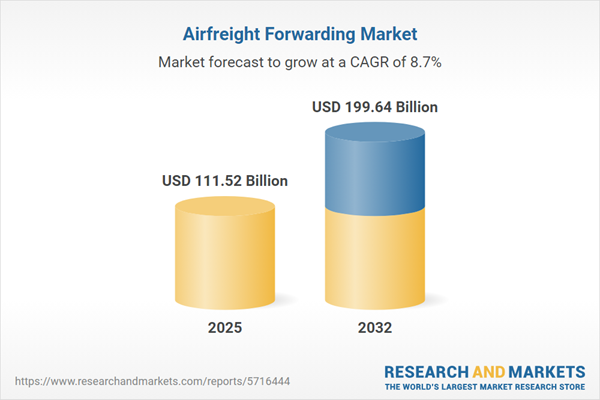Speak directly to the analyst to clarify any post sales queries you may have.
The airfreight forwarding market is undergoing rapid transformation, fueled by digital advancements, evolving service models, and stringent global compliance requirements. Senior executives in the sector face growing complexity as they seek to build flexible, resilient logistics operations while capitalizing on emerging growth avenues.
Market Snapshot: Airfreight Forwarding Market Size and Growth
The global airfreight forwarding market is projected to reach USD 102.50 billion in 2024, moving to USD 111.52 billion by 2025, and anticipated to achieve USD 199.64 billion by 2032. This expansion, at a compound annual growth rate (CAGR) of 8.69%, demonstrates rising dependence on reliable logistics and robust digital tools, particularly for temperature-controlled shipments and high-value goods. Organizations worldwide are intensifying digital transformation initiatives and fortifying supply chain strategies to adapt to market volatility, shifting customer needs, and new risks shaping the industry landscape.
Scope & Segmentation: Strategic Opportunities in the Airfreight Forwarding Market
This report outlines a comprehensive segmentation framework, enabling decision-makers to deploy targeted strategies and reinforce leadership positions across the airfreight forwarding market:
- Service Types: Consolidation, charter services, expedited delivery, and onboard couriers support urgent and specialized freight requirements, offering precision for shipments sensitive to time or condition.
- Mode of Service: Airport-to-airport, airport-to-door, door-to-airport, and door-to-door options empower organizations to select adaptable routing, optimizing shipment efficiency for varying supply chain needs.
- Shipment Size: Full aircraft and partial shipment arrangements help leaders control costs and improve asset utilization while responding to specific client demands.
- Commodity Types: Solutions for automotive, electronics, pharmaceuticals, perishables, and retail goods enable compliance and preservation for diverse cargo profiles, ensuring safe shipment regardless of complexity.
- End-Use Industries: Aerospace, defense, healthcare, FMCG, automotive, and electronics industries gain tailored support through sector-focused logistics and operational enhancements, maintaining continuity and scalable process improvements.
- Shipment Priority: Expedited and standard flows, including onboard couriers, help organizations manage urgency and cost structures, aligning with operational objectives.
- Geographic Coverage: The report delivers actionable insights across the Americas, Europe, Middle East, Africa, and Asia-Pacific, supporting precise market entry decisions and active risk management for regional execution.
- Featured Companies: Profiles covering Kuehne + Nagel, DHL Global Forwarding, DB Schenker, DSV Panalpina, Expeditors, Nippon Express, Kintetsu World Express, CEVA Logistics, Bolloré Logistics, and Geodis demonstrate effective digital strategies and competitive approaches essential for market leadership.
The segment structure supports data-driven technology investments and localized go-to-market planning, strengthening customer engagement and operational optimization.
Key Takeaways: Strategic Insights for Senior Decision-Makers
- Digital platforms are enabling real-time supply chain monitoring, integrating automation to support business continuity in uncertain conditions and helping companies quickly adapt to disruptions.
- Environmental priorities are driving changes in transport methods and procurement strategies as operators refine their sustainability efforts to meet heightened compliance standards.
- Electronic documentation and blockchain-based procedures are accelerating customs processes, limiting regulatory exposure, and increasing cross-border shipping efficiencies for international operators.
- On-demand offerings, such as charter flights and onboard couriers, are supporting secure, time-critical, and high-value shipments, granting greater flexibility to logistics networks.
- Regional strategies continue to diversify, with North America pushing advanced cold chain solutions, Europe and the Middle East focusing on lower-emission models, and Asia-Pacific increasing capacity for manufacturing and e-commerce fulfillment.
- Sector consolidation through mergers and acquisitions is improving global network reliability, expanding provider portfolios, and enhancing service quality for key clients.
Tariff Impact: Navigating Shifting US Policies
Recent adjustments in US tariffs and regulations have led airfreight forwarders to adjust their routing and capacity plans. Strategic partnerships with customs and insurance experts help reduce operational risks, while adopting integrated multimodal logistics and defined cargo classifications maintains regulatory alignment and responsiveness to policy changes.
Methodology & Data Sources
Insights in this analysis are drawn from senior executive interviews, sector-specific studies, regulatory evaluations, and proprietary industry data. All findings are subjected to rigorous quantitative validation and benchmarking to ensure credibility and relevance for company leadership.
Why This Report Matters for Senior Decision-Makers
- Provides actionable intelligence for assessing risk and preparing for evolving trends in digital technology, environmental obligations, and international regulations.
- Enables senior leaders to react quickly and effectively to digital transformation and shifting operational landscapes in diverse regions.
- Supports resilient supply chain strategies that help organizations secure a strong foothold as the airfreight forwarding market adapts.
In conclusion, this report empowers executives to navigate ongoing changes in the airfreight forwarding market, equipping leaders with the insights essential for guiding successful logistics strategies in a shifting global environment.
Additional Product Information:
- Purchase of this report includes 1 year online access with quarterly updates.
- This report can be updated on request. Please contact our Customer Experience team using the Ask a Question widget on our website.
Table of Contents
3. Executive Summary
4. Market Overview
7. Cumulative Impact of Artificial Intelligence 2025
Companies Mentioned
The companies profiled in this Airfreight Forwarding market report include:- Kuehne + Nagel International AG
- DHL Global Forwarding
- DB Schenker
- DSV Panalpina A/S
- Expeditors International of Washington, Inc.
- Nippon Express Co., Ltd.
- Kintetsu World Express, Inc.
- CEVA Logistics AG
- Bolloré Logistics SAS
- Geodis SA
Table Information
| Report Attribute | Details |
|---|---|
| No. of Pages | 182 |
| Published | October 2025 |
| Forecast Period | 2025 - 2032 |
| Estimated Market Value ( USD | $ 111.52 Billion |
| Forecasted Market Value ( USD | $ 199.64 Billion |
| Compound Annual Growth Rate | 8.6% |
| Regions Covered | Global |
| No. of Companies Mentioned | 11 |









